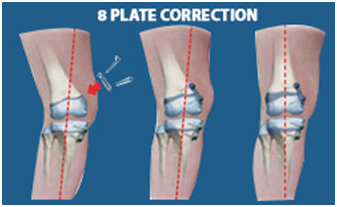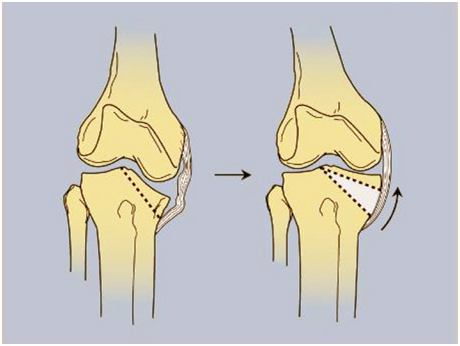Blount Disease Treatment in Gurgaon, Delhi NCR
Blount Disease is an important cause of non-resolving bowed legs. Surgery is the most recommended way to resolve the bowed legs condition in children and adolescents. Dr. Ratnav Ratan is an expert orthopedist in NCR and Gurgaon with surgical expertise in treating bowed legs conditions for best outcomes.
What is Blount Disease?
Blount disease is a growth disorder diagnosed in children below 4 years of age and in teenagers. The bones of the lower leg are affected and they bow outwards.
If the bowed legs condition is not resolved by the time the child turns 3 years of age then a doctor’s evaluation is essential. Teenagers with excess weight are more likely to develop bowed leg conditions.
Types of Blount Disease

- Early Onset of Blount disease
This condition is also referred to as Infantile Blount’s Disease as it occurs to children less than 3 years of age. The reason is unknown and it affects the proximal posteromedial tibial growth plate. The child will experience progressive bowing of the tibia leading to further deformity and limb length discrepancy.
- Late Onset of Blount disease
Late-onset Blount disease occurs after the children is 4 years of old. This condition is further categorized into juvenile Blount disease that occurs in children between 4 -10 years of age while the adolescent stage of Blount disease occurs in children above 10 years of age and is associated with obesity and is unilateral in condition implying bowing visible in one limb only.
Symptoms of Blount Disease
The bowed legs are visible when the child is standing. Also, the child will have awkward walking patterns. Usually, a child with bowed legs will have normal coordination and begin to walk as per his or her age. Parents and family members are likely to be anxious over the bowed leg condition of the child.
Intoeing or turning in of the feet can also occur along with bowed legs in some children.
Adolescent children with bowed legs are likely to complain of pain in the knees, hips, and ankles due to the additional stress on the joints on account of their leg condition. Also, frequent tripping instance of the child due to intoeing indicates the need to treat the bowed leg condition.
Doctor’s Examination and Diagnosis
The doctor will evaluate the child and also conduct a thorough physical examination. A healthy child up to 2 years of age with the same amount of bowing in both the legs i.e. symmetrical bowing is considered normal while the parents have to remain observant regarding the bowing of legs. In the case of asymmetrical bowing, an x-ray image of the lower legs especially in the standing position reveals the exact condition and the cause of bowing which could be either Blount’s disease or rickets.
For a child beyond 2 ½ years with symmetrical bowing, the treating orthopedist will suggest an x-ray for an accurate diagnosis to ascertain either infantile Blount’s disease or rickets. If required, blood tests will be recommended to confirm the presence of rickets.
If your child is older than 2 1/2 years at the first doctor’s visit and has symmetrical bowing, your doctor will most likely recommend an x-ray. The likelihood of your child having infantile Blount’s disease or rickets is greater at this age. If the x-ray shows signs of rickets, your doctor will order blood tests to confirm the presence of this disorder.
Causes of Blount Disease
Blount disease affects both children and adolescents. It occurs due to the abnormal condition of the growth plates which are located at the end of the long bones of the child. The growth plates determine the shape and the length of the adult bone.
It is only after the child turns 3 years, an x-ray of the child’s legs can reveal Blount’s disease is present.
Treatment of Blount Disease
In cases of untreated infantile Blount disease, the bowing conditions worsen progressively during the growing years of the child and adolescence stage. The child may complain of discomfort in the legs especially the knee areas as the joints are under abnormal stress. The child may experience pain with bowing if he or she has Blount disease.
Nonsurgical Treatment for Blount disease.
Infants with Blount’s disease need to be treated to improve their bowing. The child may have to wear a brace if Blount disease is detected early. However, bracing does not give desired results in adolescents affected by Blount’s disease.
Surgical Treatment for Blount disease.
Surgery is necessary to stop the worsening and preventing further damage to the shinbone’s growth in case of non-desired results after bracing in a child with infantile Blount’s disease. This surgery is recommended by the child reaches 4 years of age.
Similarly in the case of adolescents with Blount’s disease surgery is performed to resolve the bowing of legs issue.
There two main types of surgical procedures that are recommended depending upon the bowed legs condition.
- Guided growth also known as Growth modulation with 8 plates
 This surgery is performed on the normal side of the top of the shinbone. The surgeon puts a staple or a small metal plate to stop the growth temporarily. This enables the abnormal side an opportunity to grow and straighten the leg with the natural growth of the child. Once the condition improves, the staple or the plate is removed and normal growth resumes.Growth modulation with 8 shaped plate which is the size of a paper clip is used to enable gradual correction of the deformed limb. The plate is attached to the bone using screws and it performs like a hinge enabling to become more flexible and decrease its compression on the growth plate.The treating orthopedic surgeon will have to ensure the proper degree of flexibility in the 8 plate for the best outcome of correction. Through this procedure, the bone growth of one side of the deformity is restricted enabling the other side of the bone to grow and align in a gradual but natural manner.
This surgery is performed on the normal side of the top of the shinbone. The surgeon puts a staple or a small metal plate to stop the growth temporarily. This enables the abnormal side an opportunity to grow and straighten the leg with the natural growth of the child. Once the condition improves, the staple or the plate is removed and normal growth resumes.Growth modulation with 8 shaped plate which is the size of a paper clip is used to enable gradual correction of the deformed limb. The plate is attached to the bone using screws and it performs like a hinge enabling to become more flexible and decrease its compression on the growth plate.The treating orthopedic surgeon will have to ensure the proper degree of flexibility in the 8 plate for the best outcome of correction. Through this procedure, the bone growth of one side of the deformity is restricted enabling the other side of the bone to grow and align in a gradual but natural manner. - Hemiplateau elevation
 Early treatment of Blount disease is always recommended, further it varies from patient to patient depending upon the stage of disease and the age of the patient. However, the patient may develop progressive limb length discrepancy, gait abnormalities and early onset of osteoarthritis.The goal of the operation hemiplateau elevation is to restore the normal configuration of the articular surface of the proximal end of the tibia. This is possible through direct elevation of the depressed medial tibial plateau accompanied by osteotomy towards correcting the alignment of the tibia.Also, as per requirement, complex procedure of deformity can be planned to include hemiplateau elevation (simultaneous or staged) accompanied with correction of tibial metaphyseal deformity, lengthening and epiphysiodesis procedure.
Early treatment of Blount disease is always recommended, further it varies from patient to patient depending upon the stage of disease and the age of the patient. However, the patient may develop progressive limb length discrepancy, gait abnormalities and early onset of osteoarthritis.The goal of the operation hemiplateau elevation is to restore the normal configuration of the articular surface of the proximal end of the tibia. This is possible through direct elevation of the depressed medial tibial plateau accompanied by osteotomy towards correcting the alignment of the tibia.Also, as per requirement, complex procedure of deformity can be planned to include hemiplateau elevation (simultaneous or staged) accompanied with correction of tibial metaphyseal deformity, lengthening and epiphysiodesis procedure. - Tibial osteotomy The operating surgeon cuts the shin bone below the knee to reshape it and correct the alignment. The bone is held in place with an internal plate and screws till it heals. If required, an external frame is placed outside the leg. Post-surgery, a cast is applied to protect the bone as it heals. The child may have to use crutches for some time. The child may have to undergo physical therapy exercises to regain strength and range of motion.It is advisable to treat Blount Disease as early as possible as delay in treatment leads to abnormal gait and stress on joints which is likely to affect their future to a great extent. Dr. Ratnav Ratan is available in NCR and Gurgaon for consultation and treatment of bowed leg conditions.




